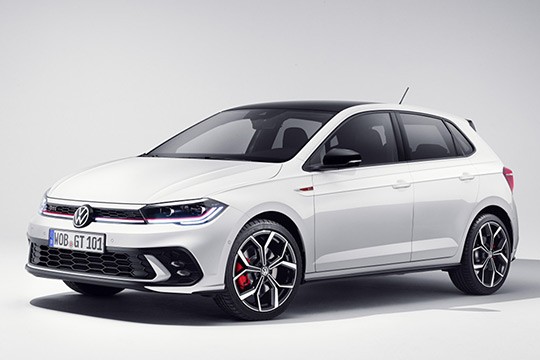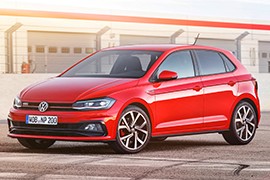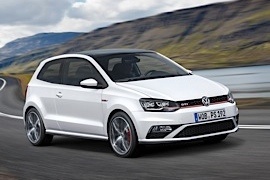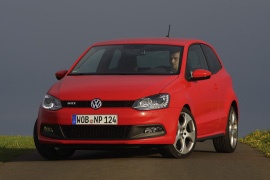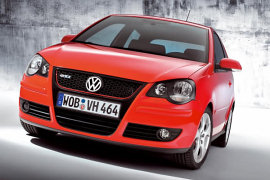VOLKSWAGEN Polo GTI Models/Series Timeline, Specifications & Photos
First production year: 2005
Engines: Gasoline
Body style: Hatchback
In 1975, Volkswagen introduced the inaugural Polo model, followed by the Scirocco GTI in the subsequent year. Despite the long-standing presence of these two names for nearly fifty years, it wasn't until 1998 that the GTI version made its way to the third generation of Polo. Since then, this vehicle has gained recognition in the compact category for its practicality, efficiency, and racing aspirations.
Leveraging the reliability of the base model and incorporating speed-focused characteristics, the new Polo GTI stands out as an enjoyable and affordable option for daily driving. With its upgraded technology, drivers can enjoy a comprehensive driving experience that combines classic manual control with a semi-automated mode.
The IQ.DRIVE Travel Assist system enables the car to take control of steering, braking, and acceleration between 0 and 130 mph (209 kph). It cleverly integrates two simpler systems, adaptive cruise control and lane assist. However, it is essential to note that the driver must always keep their hands on the steering wheel all the time, hence the semi-automated nature.
Staying true to the Polo's tradition, the engine delivers efficiency with moderate fuel consumption, complemented by a DSG transmission. A sport chassis, lowered by two-thirds of an inch, contributes to the car's dynamic stance. The lightweight construction enhances the great alignment of its components and makes the driver who sits behind the sport leather wheel feel like the car can conquer any racetrack.
While the compact body of the car affects its luggage capacity, providing a relatively modest 351 liters of capacity, there are some other advantages. For instance, the reduced dimensions make the optional 18-inch alloy wheels appear larger and more stylish, lending the Polo a sportier appearance that may offer a morale and performance boost.
The car's rear also has implemented new LED lights featuring animated brake lights and integrated dynamic indicators that make the Polo stand out more even when casually strolling through the city. The chrome exhaust pipe not only transfers the roar of the engine in a very mannered way but also makes a good contrast with the GTI marking from the back of the car.
Efficiency is the keyword when talking about the German heritage of the car, as the instruments and infotainment system are strategically positioned within the driver's field of vision for easy readability and usability in all kinds of situations.
Despite keeping up with advanced technology, such as including a six-speaker Beats sound system to complement the 10.25 inches display, the main attraction of the interior remains the distinctive GTI touch.
The trademark red contrast stitching, Titanium Black trim color for the roof pillars, and roof liner accentuate this compact Volkswagen's performance-oriented character. Combining red, black, and chrome design elements enhances the interior's very sleek appearance.
Based on the 7th generation of the regular Polo, the new Polo GTI was a comfortable and refined hot hatch.
While Polo never made it as far as the flagship Golf did, the new GTI drew immediate attention. And it also drove like a Golf, sharing its MQB chassis.
For starters, the GTI version could easily be recognised with the specific exterior design that featured red accents, especially at the front. The front radiator grille had a red stripe in the middle and with the optional LED headlights, the red winglets added to the aggressive design of the small car.
At the rear, the GTI version featured a black painted honeycomb structure, dual chrome tailpipes and the GTI lettering on the trunk lid.
Inside, VW installed only well-grained and sout to the touch materials, while the overall design was comfortable and sporty. To further point out the GTI character, bold red stitching was added.
The super comfortable body-hugging seats looked expensive and were available with both leather and cloth upholstery.
As standard, every GTI was fitted with a central 6.5-inch touchscreen infotainment system with standard Android Auto and Apple CarPlay.
Driven by a 2.0-liter turbocharged engine that produced 210 hp and 258 pound-feet of torque. Performance could be increase to 220 hp with the Performance package.
After the facelift for the entire generation of the Polo family, the GTI was refreshed too. Since it is the best super-mini German vehicle, it had to come with some features to stand out of the crowd. On the front, a honeycomb grille and a red stripe are showing the car's sporty intentions. On the front fenders, there are red and chromed GTI badges like those found on its bigger brother, the Golf GTI.
Inside, it looks like it is a Golf GTI reduced in scale. There are the same design GTI steering wheel, the GTI dashboard and the design of the fabric on the seats similar to its bigger brother. The overall dashboard look doesn't seem different from the other Polo's. The infotainment unit is still the same, but good, with a large enough touchscreen and few buttons.
In the rear, there is room for four and, since it has the same MQB platform, it has the same intrusion on the center tunnel. The Polo GTI is available as a three or five-door, so if someone would plan to use it as a family car, it is ok. The rear seats also have Isofix child-seats anchoring systems.
It is very important to know that this Polo GTI can feature an automatic transmission with a double-clutch or a standard six-speed manual. The suspension was stiffened compared to the rest of the Polo range.
The little Polo GTI aimed high at the small-segment leader, the Renault Clio RS, with a turbocharged four-banger and an automatic DSG gearbox.
When the compact hot-hatches became too expensive for young people, the carmakers started offering small-segment cars with more powerful engines. The Volkswagen Polo GTI had to face stiff competition against the Clio RS, Peugeot 207 GTI, Ford Fiesta ST, and Opel Corsa OPC. But the inventor of the hot-hatch category didn't give up and transformed the little Polo into a pocket rocket. Volkswagen introduced it in 2005 and has evolved ever since. By 2010 it was already on its second generation, and the carmaker knew what its customers asked from the Polo GTI.
Its three-door bodywork worked perfectly with the car's performance. At the front, it featured LED headlights with daytime running lights. The bumper was wide and sported a large air-dam, while the two-slats main grille looked like it was just another box on wheels. At the back, Volkswagen installed a roof-spoiler at the top of the tailgate while a dual exhaust confirmed the car'' status.
Inside, the carmaker installed a Tartan upholstery, which resembled the original Golf GTI. Volkswagen installed a standard touch-screen infotainment display on the center stack, named "Composition Touch," with Bluetooth connectivity and screen mirroring for mobile phones. In the back, it was the same 60/40 split-folding bench which increased the trunk size from 204 liters (7.2 cu-ft) to 992 liters (31.1 cu-ft).
Under the hood, Volkswagen installed an upgraded Scirocco, 1.8-liter engine. Its 192 hp was enough to drop the 0 to 62 mph (0-100 kph) time to 6.9 seconds. The standard gearbox was a six-speed manual, while the carmaker offered a seven-speed (dual-clutch) automatic as an option.
When Volkswagen introduced the fourth generation of the Polo in 2002, it didn't make it a GTI, and the small hot-hatch fans remained disappointed until 2005.
Along with the facelifted version of the Polo's fourth generation, the carmaker re-introduced the GTI version as well. It offered more power than its predecessor, and it was a pocket-rocket that could outpace many cars on the road and still managed to keep a decent fuel consumption. It was like Santa Claus in July. Unless it was unveiled in October at the Australian International Motor Show. The recipe was simple: take the three-door version, stuck the biggest engine it fits inside the engine bay, and call it a day.
Volkswagen used the three-door version of the Polo hatchback, with the new, wider headlights. Its front fascia featured a big, V-shaped, black grille with a red stripe on the upper side. In the apron, the carmaker installed two side-scoops that hosted the fog lights and a pair of fake air intakes. Its longer doors and the fixed rear windows were carried over from the 3-door Polo, while at the back, a small roof-spoiler adorned the top of the liftgate.
Inside, the carmaker chose the upholstery better and mounted bolstered seats at the front. The three-spokes steering wheel sported a silver badge with GTI lettering. But there were no white dials or screaming-for-attention elements. The only unique feature was the aluminum pedals.
Under the hood, Volkswagen installed the same 1.8-liter turbocharged engine used for more cars, such as the Audi A3, Audi TT, Volkswagen Passat, or Skoda Octavia RS. It provided 150 hp and was paired to a five-speed manual only. Later on, a Cup edition received an upgraded version with 180 hp.
